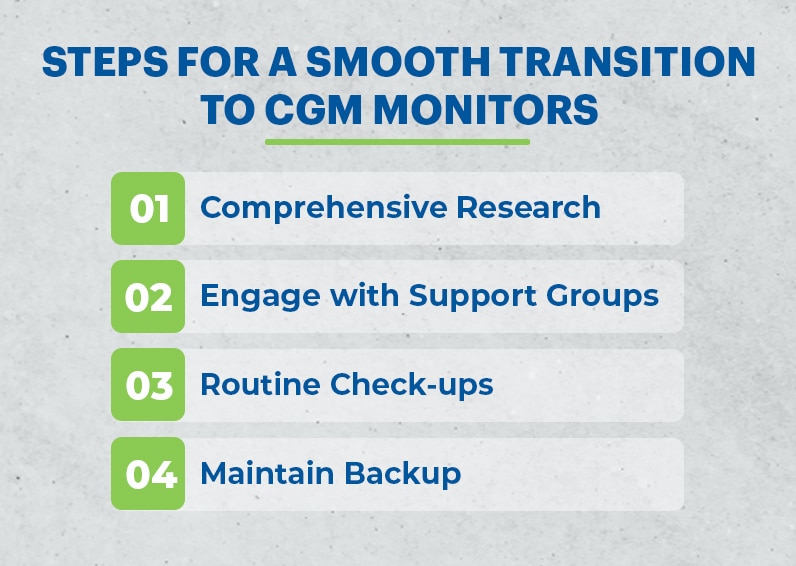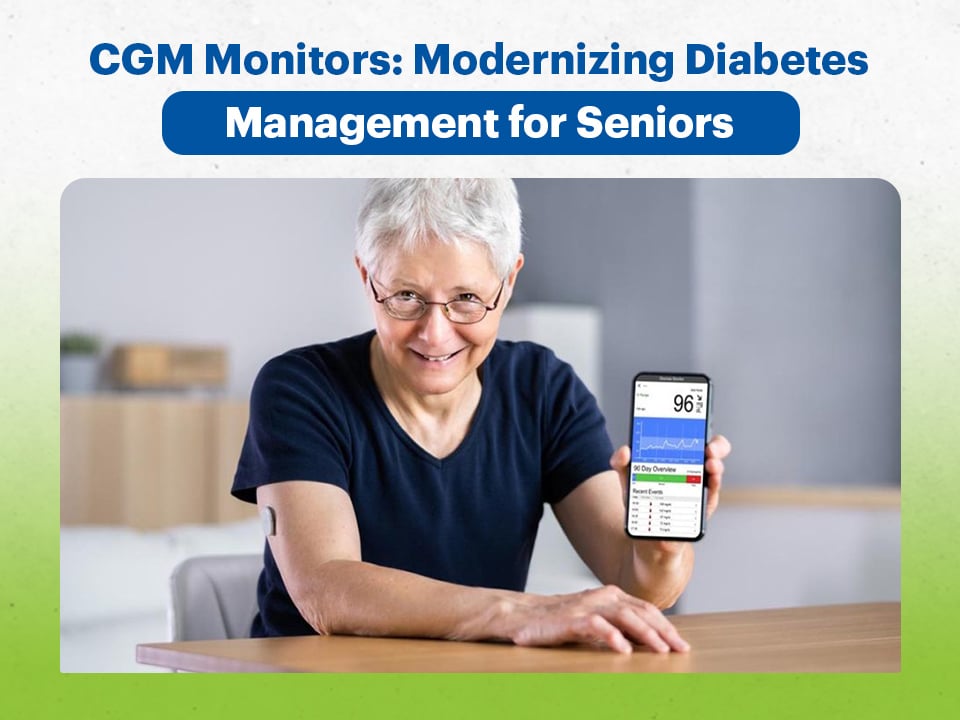Diabetes has been a persistent adversary for health practitioners and patients alike, presenting challenges that span across generations and demographics. For seniors, the battle is even more complex. Age brings along not just wisdom and experience but also a myriad of health complications, many of which can exacerbate the intricacies of diabetes management. The frequent need for blood sugar checks, the daunting task of keeping up with medications, and the relentless balancing act of diet and exercise all compound the daily struggles of an elderly diabetic.
In this landscape, Continuous Glucose Monitoring (CGM) systems emerge as a beacon of hope. These advanced devices are not just technological breakthroughs but thoughtful innovations tailored to make diabetes management more efficient, less intrusive, and ultimately more compatible with the lifestyle and needs of seniors.
Understanding CGM
Continuous Glucose Monitoring, commonly abbreviated as CGM, represents one of the most transformative innovations in the realm of diabetes management. This system utilizes a minuscule yet sophisticated sensor, generally inserted into the fatty tissue under the skin, usually on the abdomen or arm.
Once in place, the sensor measures glucose levels in the interstitial fluid (the fluid between cells). These readings are then transmitted to a receiver or compatible device, such as a smartphone, presenting users with almost instantaneous glucose data. Unlike conventional methods that offer a snapshot of glucose levels at a single point in time, CGM provides a continuous flow of information, charting the rise and fall of glucose levels throughout the day and night.
A noteworthy advantage of CGM is its ability to significantly minimize if not entirely eliminate, the need for repetitive and painful finger pricks, which have long been a mainstay in diabetes management. Instead, users can access a wealth of glucose data at a glance, benefiting from the system’s ability to highlight patterns and trends. This dynamic, real-time glucose monitoring can lead to more informed decisions regarding diet, activity, and medication.
The Rising Need for CGM in Seniors
In our rapidly advancing technological era, it’s crucial that healthcare innovations adapt to the requirements of all age groups, especially seniors. With age, the body undergoes numerous physiological changes, many of which can impact the management of chronic conditions like diabetes. The traditional methods of disease management, though effective, often fall short of addressing the specific challenges faced by the elderly. Hence, tools like CGM aren’t just luxuries; they are becoming essential components of comprehensive healthcare for senior citizens. As we delve deeper into the nuances of this demographic’s needs, it’s clear why the push for CGM adoption is stronger than ever.
1. The Aging Diabetic Population
Diabetes is no longer a condition limited to a specific age group. With the global rise in diabetes cases, there’s a clear trend of increasing diagnoses among the senior population. As they age, seniors contend with not only the regular challenges posed by diabetes but also those associated with other age-related conditions. This amplifies the need for more advanced, user-friendly tools that can simplify and enhance the quality of diabetes care.
The convergence of an aging global population and rising diabetes diagnoses underscores the necessity for systems like CGM. It’s not just about making glucose monitoring easier; it’s about adapting to the evolving needs of an older generation who deserve efficient tools that can help maintain their health and independence.
2. Physical Limitations
Age often ushers in various physical challenges that can make daily tasks more arduous. Reduced tactile sensation, diminished vision, and limited manual dexterity can make the traditional method of drawing blood and using glucose meters cumbersome and sometimes ineffective. These meters, though valuable, often require careful handling and precise actions – from pricking the finger to applying the blood sample correctly.
Enter CGM systems. Their less invasive nature and user-friendly interface make them an ideal alternative for seniors. With larger displays, auditory alerts, and minimal manual input needed, CGMs circumvent many of the issues associated with traditional glucose monitoring methods. The bonus? They provide a wealth of data that can be shared with caregivers or medical professionals, ensuring that seniors receive the best care tailored to their unique needs.
Distinct Features Tailored for Seniors
Modern Continuous Glucose Monitoring (CGM) systems are not just technological marvels; they are crafted with features specifically designed to cater to seniors’ unique needs. These features aim to simplify usage while maximizing health benefits.

1. Instantaneous Alerts
The unpredictability of diabetes necessitates tools that can provide instant feedback. CGMs are structured to deliver immediate notifications for significant glucose fluctuations, offering a critical safeguard against potential emergencies.
2. Detailed Glucose Reports
Beyond just numbers, the richness of data offered by CGMs paints a comprehensive picture of a senior’s glucose health. Such detailed reports form the cornerstone of informed, proactive health decisions.
3. Integration with Smart Devices
Embracing the digital era, CGMs are built to effortlessly merge with devices commonly used by seniors today. This integration ensures that the transition to using CGMs is as seamless as possible.
Read More: Manage Your Glucose Levels with Reliable CGM Monitors
Grasping the Limitations
While CGMs are revolutionary in diabetes management, they are not without their challenges. Acknowledging these limitations ensures users can maximize benefits while being prepared for potential hiccups.
1. Periodic Calibrations
Precision in diabetes management is non-negotiable. Thus, to maintain the impeccable accuracy of CGMs, periodic cross-references with traditional glucose meters become necessary.
2. Skin Reactions
Every individual’s skin is unique, and while CGMs are designed for universal comfort, some seniors may encounter sensitivities. It’s essential to recognize and address these concerns early.
Steps for a Smooth Transition to CGM
Embracing CGMs involves more than just purchasing a device. It’s a journey that, when navigated strategically, can significantly enhance the quality of life for diabetic seniors.

1. Comprehensive Research
Informed choices are always the best. Seniors are encouraged to deeply explore their options, weighing the pros and cons of different CGM models.
2. Engage with Support Groups
There’s immense value in shared experiences. By connecting with other CGM users, seniors can benefit from a treasure trove of insights and practical tips.
3. Routine Check-ups
The adoption of technology should complement, not replace, regular medical consultations. Routine visits to healthcare professionals ensure optimal device use and health monitoring.
4. Maintain Backup
A blend of old and new often provides the best results. While CGMs are the vanguard of diabetes management, traditional glucose meters serve as a trusty fallback when needed.
Navigating the Road Ahead
The world of medical technology is ever-evolving, with CGMs being a testament to that. They’ve transformed the way seniors manage diabetes. Continuous research and innovation promise future models that are even more efficient and user-friendly.
Furthermore, healthcare professionals are increasingly advocating for the integration of CGMs into the regular care routine for senior diabetic patients. Such endorsements solidify the belief that CGMs are not merely a fleeting trend but a sustainable solution for future diabetes care.
In Conclusion
To wrap up, while diabetes remains a formidable challenge, especially for the elderly, tools like CGM monitors are ensuring the journey is less strenuous. With continued advancements, there’s hope that diabetes management will become more streamlined, granting seniors the freedom to lead lives with minimal disruptions.
Most insurance providers cover CGM monitors, so if you’re tired of having to prick your finger all the time, Artik Medical Supply is here for you. Contact them today for a free insurance eligibility check.







